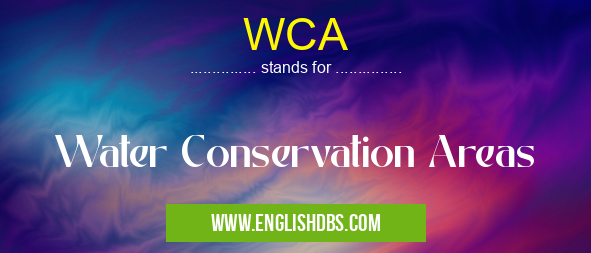What does WCA mean in CONSERVATION
WCA stands for Water Conservation Areas. Water Conservation Areas are designated areas of land or water that are managed to protect and conserve water resources. These areas may include reservoirs, lakes, rivers, streams, wetlands, and other water bodies. WCA serve important ecological functions, such as providing habitat for fish and wildlife, filtering pollutants from water, and regulating flooding.

WCA meaning in Conservation in Community
WCA mostly used in an acronym Conservation in Category Community that means Water Conservation Areas
Shorthand: WCA,
Full Form: Water Conservation Areas
For more information of "Water Conservation Areas", see the section below.
Key Functions of WCA
- Protecting Water Resources: WCA are established to protect water quality and quantity. They help to prevent water pollution, provide flood control, and ensure a reliable water supply for communities and ecosystems.
- Habitat Provision and Biodiversity Conservation: WCA provide important habitat for a wide range of plant and animal species. They support diverse ecosystems, including wetlands, forests, and grasslands, which contribute to biodiversity conservation.
- Water Filtration and Purification: Wetlands, which are often included in WCA, play a crucial role in filtering pollutants from water. They remove sediment, nutrients, and other contaminants, improving water quality downstream.
- Recreation and Education: WCA often offer opportunities for recreation, such as fishing, boating, and hiking. They also serve as educational resources, providing visitors with information about water conservation and environmental stewardship.
Essential Questions and Answers on Water Conservation Areas in "COMMUNITY»CONSERVATION"
What are Water Conservation Areas (WCAs)?
Water Conservation Areas (WCAs) are designated areas of land set aside to protect and conserve water resources, particularly in areas prone to flooding or droughts. WCAs typically consist of natural or man-made water bodies, such as reservoirs, lakes, wetlands, and floodplains.
What is the purpose of WCAs?
WCAs serve multiple purposes, including:
- Regulating water flow and reducing flood risks
- Storing water for later use during dry periods
- Recharging groundwater aquifers
- Protecting water quality by filtering pollutants and providing habitat for aquatic life
- Providing recreational opportunities, such as fishing, boating, and wildlife viewing
Who manages WCAs?
The management of WCAs varies depending on the location and specific regulations. Generally, WCAs are overseen by government agencies or organizations responsible for water resource management, such as:
- State or provincial water departments
- Federal agencies, such as the US Army Corps of Engineers
- Local conservation districts
Can the public access WCAs?
Public access to WCAs depends on the specific regulations and management practices in place. Some WCAs are open to the public for recreational use, such as fishing, boating, and hiking. However, certain areas may be restricted for conservation or safety reasons.
How do WCAs benefit the environment?
WCAs provide numerous environmental benefits, including:
- Reducing soil erosion
- Maintaining biodiversity and habitat for wildlife
- Improving water quality by filtering pollutants
- Mitigating the effects of climate change by regulating water flow and storing carbon
Final Words: WCA are vital for protecting water resources, conserving biodiversity, and providing recreational and educational opportunities. By managing and protecting these areas, communities and governments can ensure the sustainability of water resources for present and future generations.
WCA also stands for: |
|
| All stands for WCA |
